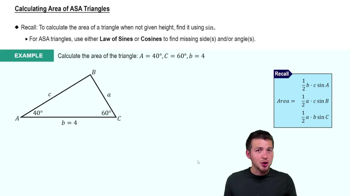Textbook Question
In Exercises 9–24, solve each triangle. Round lengths to the nearest tenth and angle measures to the nearest degree.a = 5, b = 7, C = 42°
545
views
 Verified step by step guidance
Verified step by step guidance Verified video answer for a similar problem:
Verified video answer for a similar problem:



 4:35m
4:35mMaster Intro to Law of Cosines with a bite sized video explanation from Patrick
Start learning